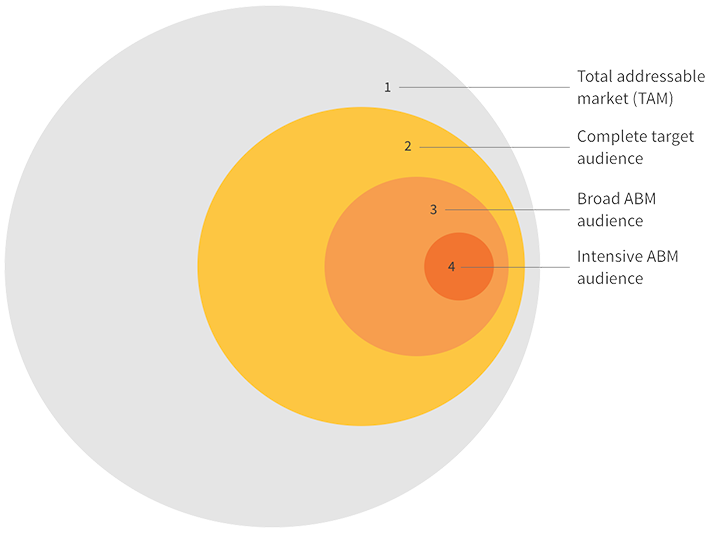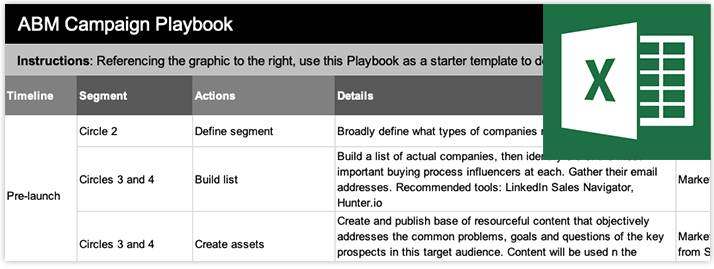
Over the last few years, there’s been a lot of buzz in the marketing world about account-based marketing – or “ABM”.
On the surface, the concept is pretty simple:
You build a list of target accounts that closely match your Ideal Customer Profile and design a collaborative marketing and sales campaign to open doors at those organizations.
But where do you start with ABM?
For example:
- How many companies should you target?
- How do you choose which to target?
- Should you focus on one individual from each of those organizations, or the entire committee of buying-process influencers? (for example, Engineers, Plant Managers, Procurement Managers, C-Suite, etc)
- Should all of your target accounts be given the same level of attention in your campaign?
- What tactics should you deploy? (email, phone calls, direct mail, custom videos, company-targeted advertising, retargeting)
- On what timeline (and with what cadence) should these tactics be deployed?
- And who on your team is responsible for executing them? Marketing? Sales? Both?
In this article, I’ll tackle these questions for you. And I’ll do so by introducing a tiered approach to account-based marketing.
In other words, I’ll show you how to segment your target audience (based on likelihood to close and potential impact for your organization) and prioritize your resources (manpower and spend) accordingly.
Finally, I’ll leave you with our ABM Campaign Playbook – a worksheet that includes a recommended implementation timeline and selection of tactical ideas to get you started with designing your own ABM campaign.
To serve champagne or sparkling water?
As the title of this article suggests, all prospects aren’t created equal.
In their 2019 book ABM is B2B: Why B2B Marketing and Sales is Broken and How to Fix it, authors Sangram Vajre and Eric Spett say that in the context of an ABM initiative, “Some accounts deserve champagne; others sparkling water”.
And for that reason, your investment of resources should be directed accordingly.
Here are a few reasons you’ll channel more time and money into the pursuit of some accounts:
1. On paper, some accounts are simply better fits
When firmographic characteristics (industry, location, size, etc) of a target account closely match those of your Ideal Customer Profile, you’ll naturally devote more resources to them.
2. Some buyers are more sales-ready
Some organizations are experiencing more pressing buying triggers than others. From external factors like looming government regulations and seasonal buying patterns to internal factors like changes in leadership, facility expansions, new product launches or labor shortages, the presence (or absence) of triggers that lead your buyers into the buying process will directly impact their sales readiness. And more sales-ready prospects often justify more of your attention.
3. The social proximity of some buyers is closer
In his 2018 book SPEAR Selling, author Jamie Shanks leans heavily into the idea that “Best-in-class account-based selling teams complement their wallet share account selection with ‘social proximity’ selection”. He goes on to define social proximity as “the relationship connectivity between people and/or companies”.
Leveraging common connections between you (or your organization) and your target prospect will significantly increase your likelihood of opening that door. Existing relationships between your company and theirs are even better.
Designing a tiered approach to your ABM campaign
Taking into account these factors that will influence the likelihood of success with any given account, here’s a visual to guide the conscious decisions you’ll make about who exactly to target (and how intensively):

Let’s break down each of these four concentric circles.
CIRCLE #1. Total addressable market (TAM)
The outermost circle represents all of the companies in your total addressable market. In other words, these are all of the organizations on this planet that could conceivably do business with you.
Now of course, just because you could do business with all of these companies, doesn’t mean you will (or should). So we’ll need to dial in much more tightly.
CIRCLE #2. Complete target audience
Circle number two represents an intentionally selected subsegment of your total addressable market.
For context, here are a few examples of what a subsegment may look like:
- Contract manufacturers in the midwest
- Specialty chemical distributors in the US
- Tier 2 Automotive Suppliers
This audience may still be very large – possibly as many as 1000 to 10,000 companies (or more depending on your market). But it’s refined enough that you can begin crafting more custom messaging to resonate specifically with these prospects.
As the authors of ABM is B2B would explain, this is the audience to whom you’ll serve the sparkling water (but probably not the champagne).
Responsibilities for the broader-reaching tactics inside of this tier will fall on the shoulders of your marketing team and may include:
- Pay-per-click advertising. You’ll target keywords this specific audience is likely to search (related to to products, services, common questions, problems, etc).
- Paid social advertising (LinkedIn, Facebook). You’ll zero in on specific job titles from specific companies in specific industries in specific geographic regions and promote resourceful content in front of them that address their biggest issues and objectives.
- Content syndication and/or guest authorship in industry journals. You’ll leverage highly-targeted and much larger audiences of industry journals, blogs and other relevant media sources to get your most resourceful content in front of more of the right people from the right companies.
CIRCLE #3. Broad ABM Audience
Next, as we tighten it up even more, we’ll draw a third, smaller circle made up of specific companies inside of your total target audience.
This subsegment represents your Broad ABM Audience and it may be 100 to 1000 accounts, depending on your market.
This is where some personalization in your account-based strategy will begin, which means more customized messaging and manual tactics.
Within these target organizations, you’ll identify the buying process influencers (actual human beings). Then you’ll craft and deliver messaging that resonates with each.
Inside this circle, a joint initiative between your Sales and Marketing teams begins to take shape, with defined responsibilities for each party.
In addition to the tactics you deployed among your more comprehensive audience in Circle #2, you’ll layer on tactics including:
- Automated email sequences. You’ll create a series of emails with highly-targeted content to deliver directly into the inboxes of the individuals you’ve identified. Because Engineers, Plant Managers, Procurement Managers and CEOs all care about different things during their organizations’ respective buying processes, the content you’ll deliver to each persona (and messaging that accompanies it) will be crafted accordingly.
- Direct mail. In a world over overcrowded inboxes, physical mail is making a comeback. And the medium is getting smarter too. For example, MailChimp’s direct mail service lets you automate the mailing of physical postcards to leads in your database who meet a certain criteria.
CIRCLE #4: Intensive ABM Audience
Finally, at the center is your Intensive ABM Audience. This micro segment might be comprised of the 10-50 most important (or highest opportunity) companies on your list of targets. How you define “most important” is up to you. I suggest focusing on accounts that:
- Closely match your Ideal Customer Profile
- Are demonstrating a higher-than-average level of buying intent
- Have a relationship with you/your company or a closer-than-average level of social proximity
If you’re gonna “pop the cork on the Dom Perignon” as Sangram Vajre and Eric Spett would say, you want to feel confident about the return on your effort.
In addition to the tactics you’ve chosen to deploy in Circles #2 and #3, you’ll layer on more personalized plays here like the following:
- Phone calls. The most traditional of sales tactics, you’re almost certainly doing plenty of this already. But could your message be more resourceful than it is salesy? (offer tips, resources and consultations rather than talking about who you are, what you do and why you’re so great). Have you created a balance in your follow-up cadence so that you’re not giving up too early, but you’re also not turning off your prospects?
- Custom videos delivered by email. This is one of my favorites. Tools like Loom make it incredibly easy to record and send a custom video in a few minutes’ time. You can use videos to introduce yourself in a more personal way than an all-text email, deliver free resources (articles, white papers, buyers guides, tools) to prospects, share relevant case studies, encourage consultations, etc. Video does two key things for you: 1) It breaks the clutter 2) It humanizes you. And the response rates on video prospecting emails blow away text emails.
- Hand-written notes. How much more likely are you to open a piece of physical mail when the envelope has been hand addressed? And what if instead of a form letter or brochure on the inside, you found a personalized, handwritten note, attached to a very relevant article that addresses a problem or question you likely have?
- More impactful direct mail. One of my favorite (and most impactful) tactics has been following up a sales call by sending a book that dives deeper into the issues discussed on that call. Books are just an example. Small gifts related to the individual’s hobbies or interests can demonstrate that you’ve been listening and appreciate the time they’ve given you up to this point. Here are some ideas for creative ways to use direct mail.
Designing your ABM campaign
Now it’s time to design a plan that makes sense for your organization. And we created a free tool to guide you.
The ABM Campaign Playbook is a working Excel spreadsheet designed to help you plan and organize your ABM tactics on a timeline, and in an actionable way.
We’ve even pre-populated it with some tactical ideas to get you started.

We hope it’s helpful!
If you’re interested in talking about account-based marketing and where it fits into your overall marketing and sales strategy, consider requesting a consultation. Here’s a look at who we help and how.